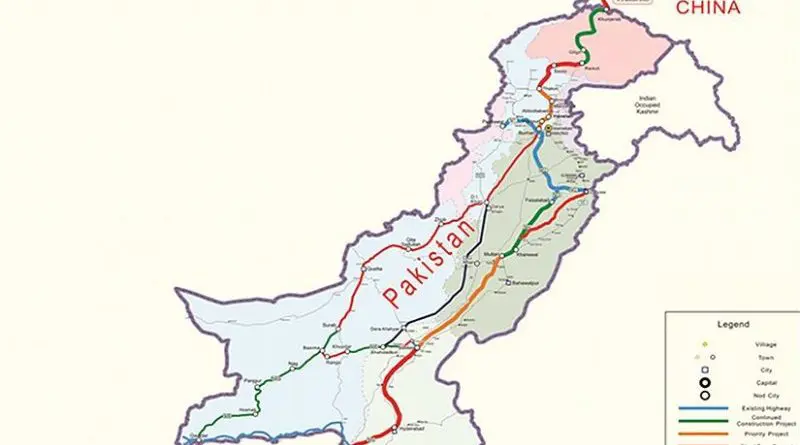The China-Pakistan Economic Corridor (CPEC): A Transformative Leap For Pakistan’s Future – OpEd
The China-Pakistan Economic Corridor (CPEC) stands as one of the most ambitious and transformative infrastructure projects that Pakistan has undertaken in its recent history, promising a profound impact on the nation’s socio-economic landscape. This multi-billion-dollar initiative is a crucial part of China’s broader Belt and Road Initiative (BRI) that aims to enhance regional connectivity and embrace a brighter economic future. The corridor stretches from Gwadar in Pakistan’s Balochistan province to Kashgar in China’s Xinjiang region, symbolizing a growth artery for economic and strategic collaboration between Islamabad and Beijing.
CPEC is poised to be a game-changer for Pakistan. By fostering infrastructural development, the project promises to spur economic growth through improved road, rail, and air transportation systems, facilitating easier and more efficient movement of goods and people within Pakistan and towards overseas markets. The development of highways, railways, and pipelines under CPEC will reduce transportation costs and logistical bottlenecks, potentially increasing Pakistan’s trade volumes significantly. Moreover, the special economic zones (SEZs) planned under CPEC are expected to attract both domestic and foreign investment, creating numerous job opportunities and fostering skill development in key industries such as manufacturing, energy, and services.
Pakistan has long grappled with energy shortages that hamper its economic growth and development. CPEC brings hope in this critical sector by including a significant focus on energy projects, which aim to add substantial capacity to Pakistan’s national grid. These projects are diverse in nature, encompassing coal, solar, wind, and hydroelectric power plants. By broadening the energy mix and increasing energy production, CPEC stands to address the chronic energy shortages that have plagued Pakistan for decades, thus powering an energy-secure future that catalyzes industrial growth and attracts further investment.
The impact of CPEC extends beyond mere economic metrics; it reaches the very fabric of society by potentially uplifting various economically lagging regions of Pakistan. The corridor’s route through less developed areas like Balochistan and Gilgit-Baltistan offers a unique opportunity to integrate these regions into the national economy more effectively. Infrastructure projects, including the development of Gwadar port, are set to transform local economies, providing new employment opportunities, enhancing local capacities, and improving living standards.
Gwadar port, often hailed as the jewel of CPEC, is set to become a bustling hub of commerce and trade that connects South Asia with the Middle East and Central Asia. The port’s strategic significance cannot be overstated, with its potential to become one of the busiest shipping lanes in the region. Moreover, the associated development of urban infrastructure around Gwadar is expected to transform the city into an economic hub, drawing significant foreign and local investment into hospitality, real estate, tourism, and retail.
CPEC has undoubtedly cemented the strategic partnership between Pakistan and China, taking it to new heights. This partnership transcends economic collaboration and ventures into mutual strategic interests, including regional security and connectivity. The trust and commitment demonstrated by China in Pakistan’s future through CPEC have not only strengthened diplomatic ties but have also provided Pakistan with a geopolitical lever in regional and international arenas.
Despite the optimism surrounding CPEC, there are significant challenges that need to be addressed to fully leverage its potential benefits. These include concerns over the transparency of agreements, debt sustainability, and ensuring that the local population benefits adequately from the project. Furthermore, security issues, particularly in Balochistan, pose risks to timely project completion and require continuous efforts to mitigate.
In conclusion, CPEC represents a cornerstone of Pakistan’s economic future, offering numerous opportunities for growth and development. While challenges exist, the strategic handling and transparent implementation of CPEC projects can lead to a prosperous outcome not only for Pakistan but for the region as a whole. As CPEC continues to unfold, it holds the promise of transforming Pakistan’s economic landscape by making it more connected, energy-secure, and economically vibrant. This corridor is not just a pathway of roads and rails; it is a corridor of opportunity and hope for Pakistan’s progress and prosperity in the decades to come.
Likewise, CPEC has faced its share of controversies, with certain groups spreading disinformation and propaganda against its implementation. These detractors often paint CPEC as a neocolonial venture by China, suggesting that it burdens Pakistan with unsustainable debt while providing minimal economic benefits to the local population. Additionally, they propagate fears about environmental degradation and loss of sovereignty, stirring public and political apprehension.
Such propaganda not only distorts the public’s understanding of CPEC but also undermines the potential socioeconomic benefits envisioned for Pakistan. These include major infrastructure upgrades, energy projects aimed at resolving Pakistan’s power shortages, and the development of trade routes significantly boosting the national economy. The spread of misinformation threatens to jeopardize these gains by inciting baseless fears and resistance among local communities and stakeholders. Pakistan’s security forces are resolutely committed to protecting CPEC projects, recognizing their critical importance to the country’s economic future. Additionally, CPEC designed to boost connectivity between Pakistan and China, represents a significant investment into Pakistan’s infrastructure and economic development.

